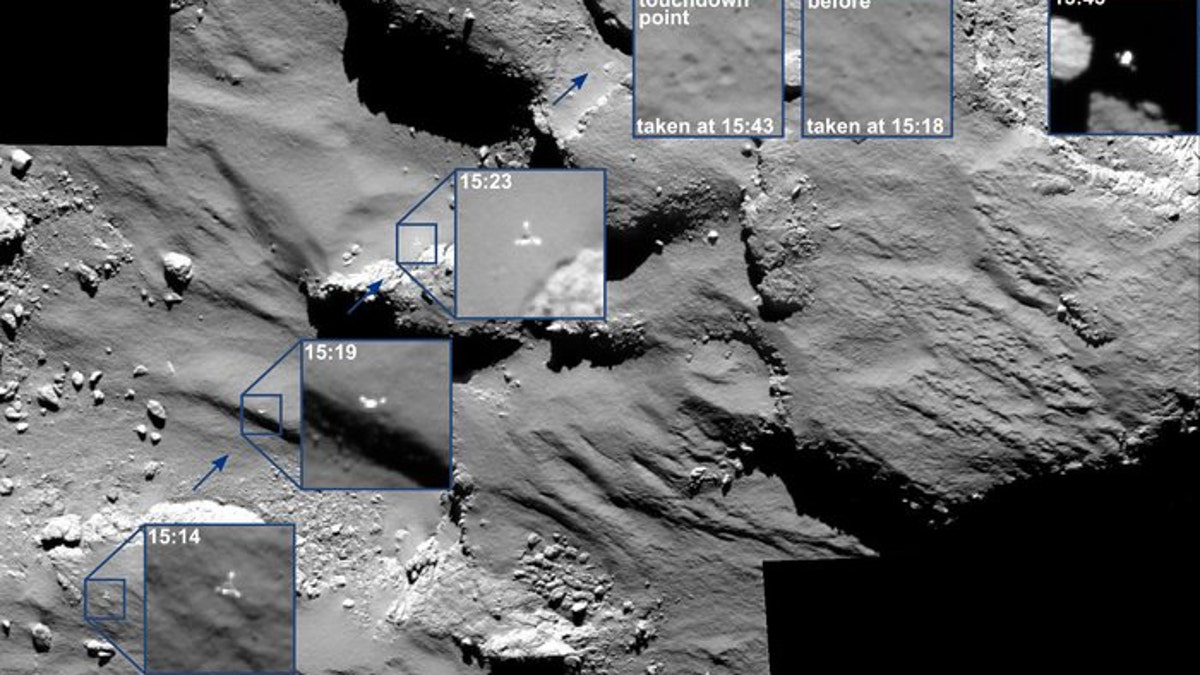
Images showing the Philae lander's journey as it approached and then rebounded from its first touchdown. (ESA/Rosetta/MPS for OSIRIS Team MPS/UPD/LAM/IAA/SSO/INTA/UPM/DASP/IDA)
It's a wake-up call taking place 300 million miles away.
The Rosetta spacecraft began listening for signs of "life" from the Philae comet lander early Thursday as the European Space Agency attempts to contact the historic probe that's been asleep for nearly four months.
Philae made headlines on Nov. 12 when it became the first probe to land on a comet, the culmination of an audacious 10-year mission. But when the lander settled into the shadow of a cliff three days later, depriving its solar panels of sunlight, it entered into "idle mode."
The comet, 67P/Churyumov-Gerasimenko, is 310 million miles from Earth.
Scientists involved in the $1.62 billion mission hope that Philae will wake up again as the comet’s orbit nears the sun. Before its battery ran out, the European Space Agency tilted the lander’s largest solar panel toward the sun in an attempt to generate future power.
The nine-day window for receiving a signal from Philae began at midnight Thursday. “Between 12 and 20 March, the Rosetta orbiter is transmitting to the lander and listening for a response,” explained the German Aerospace Center DLR in a blog post on Tuesday. According to the center, the most likely time for contact is during Rosetta’s 11 "flybys," where the orbiter’s path puts it in a favorable position to the lander during the comet’s "daytime" – when Philae is in sunlight and being supplied with power by its solar panels.
Experts, however, acknowledge that getting the lander to rise from its slumbers could prove difficult.
“It will probably still be too cold for the lander to wake up, but it is worth trying,” said Lander Project Manager Stephan Ulamec of the German Aerospace Center. “The prospects will improve with each passing day.”
Philae’s interior must be at least minus 49 degrees Fahrenheit before the lander can wake up, and its solar panels need to generate at least 5.5 watts of power. The probe needs to generate a total of 19 watts to allow two-way communication.
The German Aerospace Center says that once awakened, Philae will switch on its receiver every 30 minutes and listen for a signal from the Rosetta orbiter.
The European Space Agency faced a race against time to extract as much data from the lander as possible for the three days before it entered its hibernation.
The lander’s exact location on the comet is still unknown.
Known as a “short period comet,” 67P/Churyumov-Gerasimenko takes 6.6 years to orbit the sun. 67P/Churyumov-Gerasimenko, which is about two-and-a-half miles wide, travels at speeds of up to 84,000 miles per hour.
Follow James Rogers on Twitter @jamesjrogers
